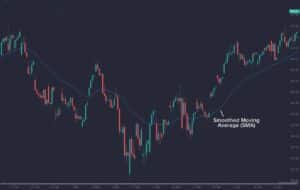Moving average envelopes are what they sound like.
Let’s take a step back and speak about moving averages for a moment.
The purpose of utilizing moving averages is to spot changes in trends.
While moving averages are an important tool to have in your technical analysis toolbox, they can sometimes give erroneous indications.
A basic purchase signal arises when prices close above the moving average, as you were taught in prior courses on moving averages.
When the price closes below the moving average, it is a simple sell signal.
Let’s imagine the EUR/USD is trending upward and closes above a moving average, signifying a long entry.
How can you be sure that this bullish trend is “real” and will last?
You don’t have it.
So, if you still want to go for the long haul, you have two choices:
- Now is the time to go long based on the original entry signal (price closed above MA)
- Keep an eye out for more proof that the trend is real.
Moving average envelopes (MAE) can aid in this situation.
Huh? Envelopes with moving averages?
Do you like it?
No, those aren’t the kind of envelopes I’m talking about.
What are Moving Average Envelopes?
A moving average envelope is made up of a moving average as well as two additional lines.
One line is HIGHER than the moving average, while the other is LOWER than the moving average.
These two lines combine to produce an upper and lower enclosure.
Because these two lines envelope (verb) the initial moving average line, it’s termed an envelope (noun). Envelopes of moving averages are used to:
- Confirm the current trend.
- Recognize overbought and oversold situations.
How to Calculate Moving Average Envelopes
It’s easy to figure out how to make a moving average envelope.
To begin, choose between a simple moving average (SMA) and an exponential moving average (EMA).
Remember that EMAs have a shorter latency because they focus more on recent prices.
Then choose how many time periods you want to apply.
Last but not least, select the percentage number for the envelopes.
A 10-day moving average with a 1% envelope, for example, would provide the following lines:
Upper Envelope: 10-day SMA + (10-day SMA x .01)
10-day SMA
Lower Envelope: 10-day SMA – (10-day SMA x .01)
The chart below shows EUR/USD with a 10-day SMA and 1% envelopes.
Take note of how the envelopes (blue lines) follow the 10-day SMA (orange line).
They stay 1% above and below the moving average at all times (orange line).
How to Confirm Trend Direction with Moving Average Envelopes
Because the moving average is the foundation of moving average envelopes (MAE), the moving average envelopes can be utilized as a trend-following indicator.
The envelopes’ direction is determined by the moving average’s direction.
price is on an uptrend when the envelopes are heading higher.
You will find the price in a downtrend when the envelopes are heading lower.
You will see that prices are neither in an uptrend nor a downturn while the envelopes are moving sideways. The price is regarded as directionless and the trend is neutral.
When the price rises above or below the envelopes, you should pay notice.
Because trends generally begin with a significant move, it is bullish if the price rises over the upper envelope.
It is deemed bearish if the price falls below the lower envelope.
Buy Signal
If the price closes above the UPPER envelope, buy.
Sell Signal
If the price closes below the LOWER envelope, sell.
Example: GBP/ USD
Notice how the upper and lower envelopes (blue lines) and the 20-day simple moving average (orange line) is trending higher in the chart below.
Take a look at how the price closed above the moving average.
Wait until the price closes above the top envelope to confirm that the trend has shifted from bearish to positive.
How to Identify Overbought and Oversold Levels with Moving Average Envelopes
There will also be times when the price moves above or below an envelope at first but then reverses.
When the moving average slope is FLAT, this happens frequently.
Moving average envelopes can be used to determine overbought and oversold levels when this happens.
Overbought can be defined as a price that moves above the upper envelope.
When the price falls below the lower envelope, the market is said to be oversold.
It’s not easy to spot overbought and oversold levels, though.
When the bullish trend is strong, a currency pair might become overbought and stay overbought.
The same can be said of being oversold. Something can be technically oversold in a strong bearish trend, but remain oversold for a long time.
This is why it’s important to pay attention to the moving average’s slope and make sure it’s flat.
Overbought and oversold levels should be confirmed with support and resistance levels.
Buy Signal
If the price touches or falls below the LOWER envelope before rising over it, purchase.
Sell Signal
Sell if the price touches or rises over the UPPER envelope then drops below it.
Example: Eur/ JPY
Notice how the 30 SMA (orange line) and the upper and lower envelopes (blue lines) are all flat in the chart below… It’s virtually horizontal.
The EUR/JPY is currently trendless. There is neither a strong bullish nor a strong bearish trend.
Look at how the upper envelope works as a powerful barrier.
Whenever the price approached the upper envelope, it fell back down.
The lower envelope is the same. Examine how it functions as a solid support level.
The price would bounce back up if it traded towards the bottom envelope.
Summary
Moving average envelopes (MAE) are a technique for confirming trend direction, but they may also be used to indicate overbought and oversold levels in sideways markets.
Looking for a highly rated forex fund manager?
Fx Pips Guru has a strong group of forex experts who are managing forex accounts of our clients from different brokers dedicatedly. Just hire our forex fund managers here: https://www.fxpipsguru.com/forex-fund-manager/.




